Structure and Properties of Ca and Zr Containing Heat Resistant Wire Aluminum Alloy Manufactured by Electromagnetic Casting
Abstract
:1. Introduction
2. Experimental Methods
3. Results
3.1. Characterization of as-Cast Structure
3.2. Effect of Cold Deformation and Annealing on Structure, Hardness and Electrical Conductivity
3.3. Properties of Wire
4. Discussion
5. Summary
- Experimental aluminum alloy containing 0.8% Ca, 0.5% Zr, 0.5% Fe and 0.25% Si (wt.%) in the form of a long-length rod 12 mm in diameter and ≈20 m in length was manufactured using an electromagnetic casting (EMC) technique. The extremely high cooling rate during alloy solidification (≈104 K/s) caused the formation of a favorable microstructure containing fine eutectic particles and full dissolution of Zr in Al solid solution. Due to the microstructure formed, the ingots possess high manufacturability for both cold drawing of a wire 3 mm in diameter and cold rolling of a strip in 2 mm in thickness.
- EMC rod hardness reaches the highest value at 450 °C annealing temperature which is associated with the formation of the L12 type Al3Zr phase precipitates with an average diameter of 10–20 nm and a high number density. Decomposition of aluminum solid solution during annealing also promotes the increase in the electrical conductivity (EC). Further increase in the annealing temperature leads to significant softening due to the coarsening of the Al3Zr precipitation structure. Deformation hardening in the cold rolled strip can be maintained at up to 450 °C annealing, which is associated with the high pinning ability of zirconium and calcium containing phases: Al4Ca, Al10CaFe2 and Al2CaSi2. Further increase in the annealing temperature leads to softening due to the recrystallization. The best combination of hardness and EC in the cold rolled strip was reached after annealing at 450 °C.
- The general structure of Al–Ca–Fe–Si system in the Al corner (including distribution of phases in the solid state and polythermal projection) was proposed.
- The experimental wire alloy had the best combination of strength (UTS = 200 MPa, YS = 180 MPa), electrical conductivity (54.8% IACS) and thermal stability (up to 450 °C) as compared with alloys on the basis of Al–Zr and Al–REM systems.
- It was shown that the presence of calcium in the model alloy increases the electrical conductivity after cold forming operations (both drawing and rolling).
Author Contributions
Funding
Institutional Review Board Statement
Informed Consent Statement
Data Availability Statement
Acknowledgments
Conflicts of Interest
References
- Polmear, I.J. Light Alloys. From Traditional Alloys to Nanocrystals, 5th ed.; Butterworth-Heinemann: Oxford, UK, 2006; pp. 129–130. Available online: https://www.elsevier.com/books/light-alloys/polmear/978-0-08-099431-4 (accessed on 29 October 2020).
- ASTM B941-16. Standard Specification for Heat Resistant Aluminum-Zirconium Alloy Wire for Electrical Purposes; ASTM International: West Conshohocken, PA, USA, 2016; pp. 1–4. [Google Scholar]
- Brubak, J.P.; Eftestol, B.; Ladiszlaidesz, F. Aluminium Alloy, a Method of Making It and an Application of the Alloy. U.S. Patent 5,067,994, 26 November 1991. Available online: https://patents.google.com/patent/US5067994A/en?oq=5067994 (accessed on 4 November 2020).
- Knych, T.; Jablonsky, M.; Smyrak, B. New aluminium alloys for electrical wires of fine diameter for automotive industry. Arch. Metall. Mater. 2009, 54, 671–676. Available online: https://www.researchgate.net/publication/263734063_New_aluminium_alloys_for_electrical_wires_of_fine_diameter_for_automotive_industry (accessed on 6 November 2020).
- Orlova, T.S.; Mavlyutov, A.M.; Latynina, T.A.; Ubyivovk, E.V.; Murashkin, M.Y.; Schneider, R.; Gerthsen, D.; Valiev, R.Z. Influence of severe plastic deformation on microstructure strength and electrical conductivity of aged Al-0.4Zr (wt.%) alloy. Rev. Adv. Mater. Sci. 2018, 55, 92–101. [Google Scholar] [CrossRef]
- Belov, N.A.; Alabin, A.N.; Matveeva, I.A.; Eskin, D.G. Effect of Zr additions and annealing temperature on electrical conductivity and hardness of hot rolled Al sheets. Trans. Nonferrous Met. Soc. China 2015, 25, 2817–2826. [Google Scholar] [CrossRef] [Green Version]
- Fu, J.; Yang, Z.; Deng, Y.; Wu, Y.; Lu, J. Influence of Zr addition on precipitation evolution and performance of Al-Mg-Si alloy conductor. Mater. Charact. 2020, 159, 110021. [Google Scholar] [CrossRef]
- Knipling, K.E.; Karnesky, R.A.; Lee, C.P.; Dunand, D.C.; Seidman, D.N. Precipitation evolution in Al–0.1Sc, Al–0.1Zr and Al–0.1Sc–0.1Zr (at.%) alloys during isochronal aging. Acta Mater. 2010, 58, 5184–5195. [Google Scholar] [CrossRef]
- Deschamp, A.; Guyo, P. In situ small-angle scattering study of the precipitation kinetics in an Al–Zr–Sc alloy. Acta Mater. 2007, 55, 2775–2783. [Google Scholar] [CrossRef]
- Lefebvre, W.; Danoix, F.; Hallem, H.; Forbord, B.; Bostel, A.; Marthinsen, K. Precipitation kinetic of Al3(Sc,Zr) dispersoids in aluminium. J. Alloys Compd. 2009, 470, 107–110. [Google Scholar] [CrossRef]
- Forbord, B.; Lefebvre, W.; Danoix, F.; Hallem, H.; Marthinsen, K. Three dimensional atom probe investigation on the formation of Al3(Sc,Zr)-dispersoids in aluminium alloys. Scr. Mater. 2004, 51, 333–337. [Google Scholar] [CrossRef] [Green Version]
- Clouet, E.; Barbu, A.; Lae, L.; Martin, G. Precipitation kinetics of Al3Zr and Al3Sc in aluminum alloys modeled with cluster dynamics. Acta Mater. 2005, 53, 2313–2325. [Google Scholar] [CrossRef] [Green Version]
- Çadırl, E.; Tecer, H.; Sahin, M.; Yılmaz, E.; Kırındı, T.; Gündüz, M. Effect of heat treatments on the microhardness and tensile strength of Al–0.25 wt.% Zr alloy. J. Alloys Compd. 2015, 632, 229–237. [Google Scholar] [CrossRef]
- Robson, J.D.; Prangnell, P.B. Dispersoid precipitation and process modelling in zirconium containing commercial aluminium alloys. Acta Mater. 2001, 49, 599–613. [Google Scholar] [CrossRef] [Green Version]
- Gao, T.; Ceguerra, A.; Breen, A.; Liu, X.; Wu, Y.; Ringer, S. Precipitation behaviors of cubic and tetragonal Zr–rich phase in Al–Si–Zr alloys. J. Alloys Compd. 2016, 674, 125–130. [Google Scholar] [CrossRef]
- Yea, J.; Guana, R.; Zhaoa, H.; Yinc, A. Effect of Zr content on the precipitation and dynamic softening behavior in Al–Fe–Zr alloys. Mater. Charact. 2020, 162, 110–181. [Google Scholar] [CrossRef]
- Vlach, M.; Stulíková, I.; Smola, B.; Žaludová, N.; Černá, J. Phase transformations in isochronally annealed mould-cast and cold-rolled Al–Sc–Zr-based alloy. J. Alloys Compd. 2010, 492, 143–148. [Google Scholar] [CrossRef]
- Belov, N.A.; Korotkova, N.O.; Alabin, A.N.; Mishurov, S.S. Influence of a silicon additive on resistivity and hardness of the Al–1% Fe–0.3% Zr alloy. Russ. J. Non-Ferrous Met. 2018, 59, 276–283. [Google Scholar] [CrossRef]
- Knych, T.; Piwowarska, M.; Uliasz, P. Studies on the process of heat treatment of conductive AlZr alloys obtained in various productive processes. Arch. Metal Mater. 2011, 56, 687–692. [Google Scholar] [CrossRef] [Green Version]
- Avdulov, A.A.; Usynina, G.P.; Sergeev, N.V.; Gudkov, I.S. Otlichitel’nyye osobennosti struktury I svoystv dlinnomernykh slitkov malogo secheniya iz alyuminiyevykh splavov, otlitykh v elektromagnitnyy kristallizator. [Distinctive features of the structure and properties of long ingots of small cross section from aluminum alloys cast in an electromagnetic mold]. Tsvet. Met. 2017, 7, 73–77. [Google Scholar] [CrossRef]
- Dobatkin, V.I.; Elagin, V.I.; Fedorov, V.M. Bystrozakristallizovannye Alyuminievye Splavy (Rapidly Solidified Aluminum Alloys); VILS: Moscow, Russia, 1995; pp. 43–59. [Google Scholar]
- Belov, N.A.; Murashkin, M.Y.; Korotkova, N.O.; Akopyan, T.K.; Timofeev, V.N. Structure and properties of Al–0.6wt.%Zr(Fe,Si) wire alloy manufactured by direct drawing of electromagnetically cast wire rod. Metals 2020, 10, 769. [Google Scholar] [CrossRef]
- Korotkova, N.O.; Belov, N.A.; Timofeev, V.N.; Motkov, M.M.; Cherkasov, S.O. Influence of heat treatment on the structure and properties of an Al–7% REM conductive aluminum alloy casted in an electromagnetic crystallizer. Phys. Met. Metallogr. 2020, 121, 173–179. [Google Scholar] [CrossRef]
- Belov, N.A.; Akopyan, T.K.; Korotkova, N.O.; Naumova, E.A.; Pesin, A.M.; Letyagin, N.V. Structure and properties of Al-Ca(Fe, Si, Zr, Sc) wire alloy manufactured from as-cast billet. JOM 2020, 72, 3760–3768. [Google Scholar] [CrossRef]
- Korotkova, N.O.; Belov, N.A.; Avxentieva, N.N.; Aksenov, A.A. Effect of calcium additives on the phase compositionand physicomechanical properties of a conductive alloy Al–0.5% Fe–0.2% Si–0.2% Zr–0.1% Sc. Phys. Met. Metallogr. 2020, 121, 95–101. [Google Scholar] [CrossRef]
- Belov, N.A.; Naumova, E.A.; Akopyan, T.K.; Doroshenko, V.V. Phase diagram of the Al-Ca-Fe-Si system and its application for the design of aluminum matrix composites. JOM 2018, 70, 2710–2715. [Google Scholar] [CrossRef]
- RPC Magnetic Hydrodynamics LLC. Available online: http://www.npcmgd.com (accessed on 10 November 2020).
- IEC 60468:1974. Method of Measurement of Resistivity of Metallic Materials, 1st ed.; IEC: Geneva, Switzerland, 1974; pp. 1–31. [Google Scholar]
- Bäckerud, L.; Chai, G.; Tamminen, J. Solidification Characteristics of Aluminum Alloys. Vol. 1: Foundry Alloys; Skanaluminium: Oslo, Norway, 1986; pp. 9–26. [Google Scholar]
- Glazoff, M.V.; Khvan, A.V.; Zolotorevsky, V.S.; Belov, N.A.; Dinsdale, A.T. Casting Aluminum Alloys. Their Physical and Mechanical Metallurgy; Elsevier: Oxford, UK, 2019; pp. 180–192. [Google Scholar]
- Thermo-Calc Software—Computational Materials Engineering. Available online: http://www.thermocalc.com (accessed on 1 December 2020).
- Belov, N.A.; Eskin, D.G.; Aksenov, A.A. Multicomponent Phase Diagrams: Applications for Commercial Aluminum Alloys; Elsevier: Amsterdam, The Netherlands, 2005; pp. 19–31. [Google Scholar]
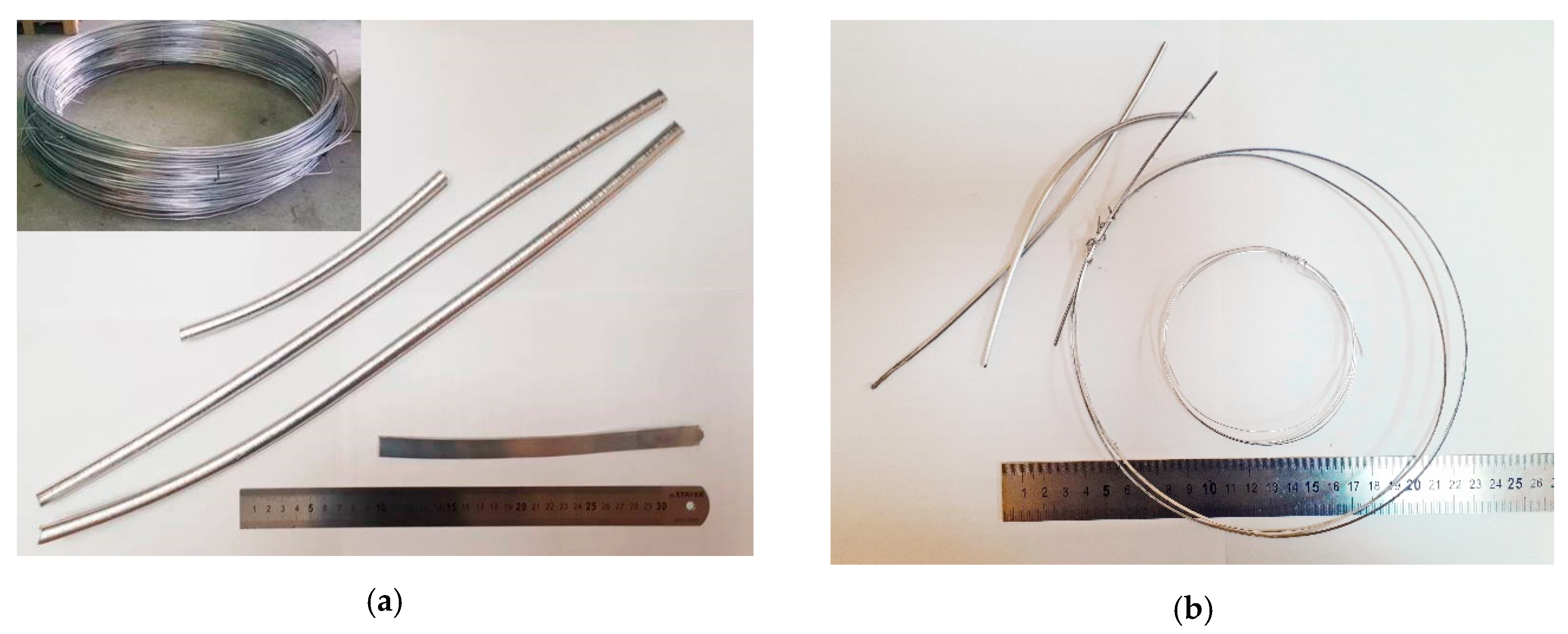

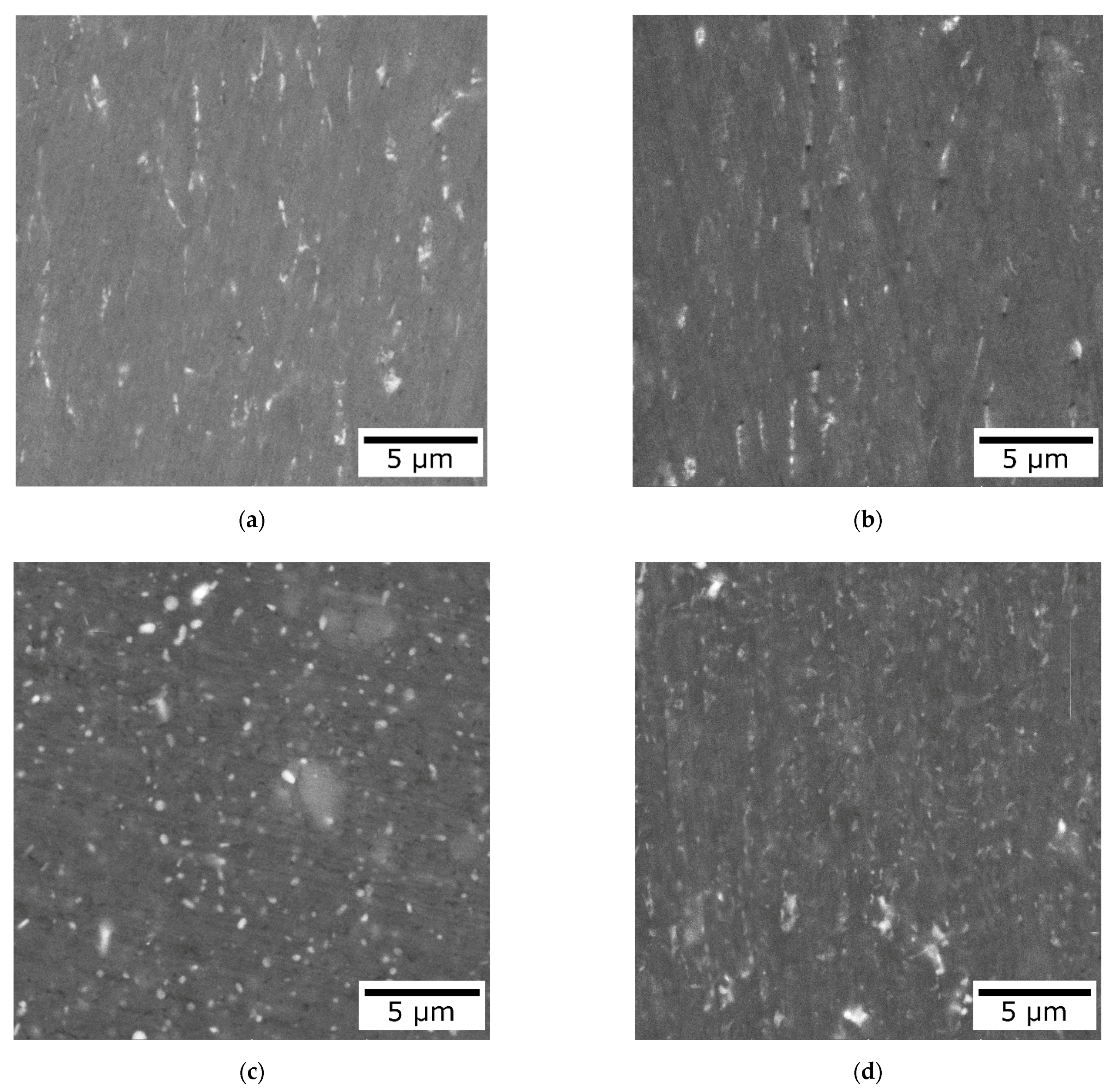

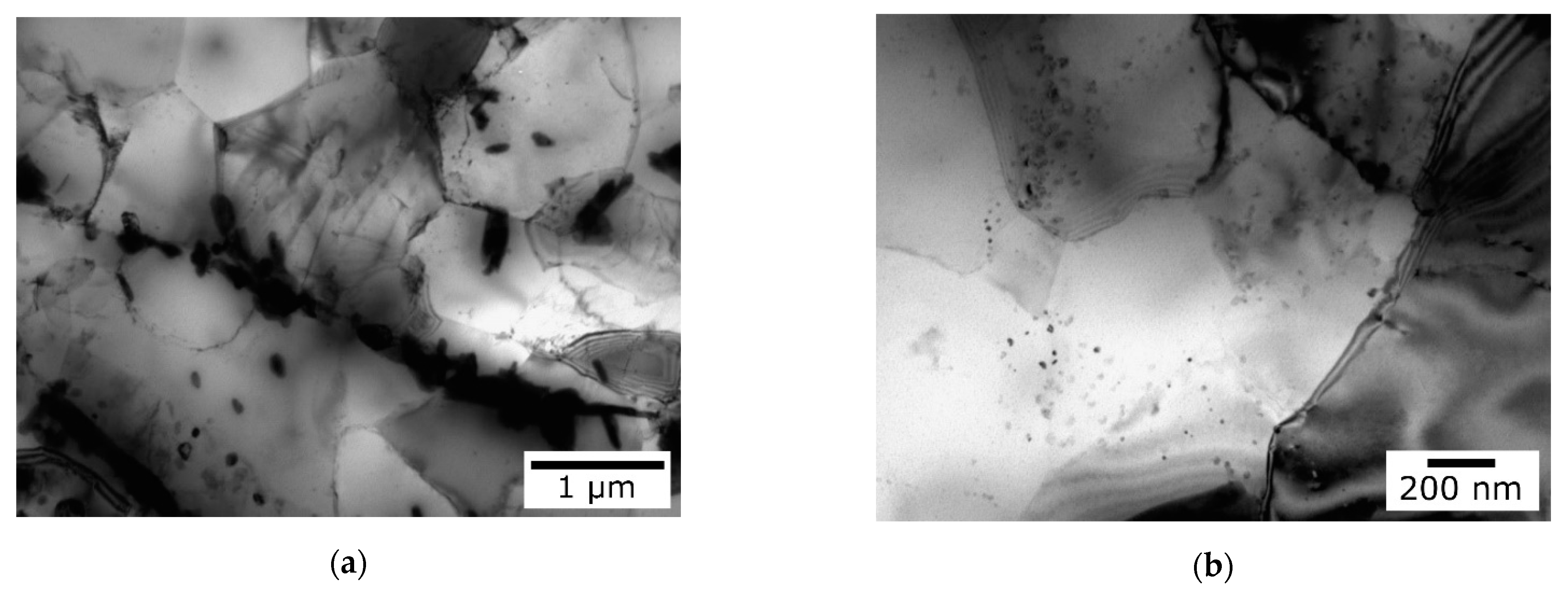
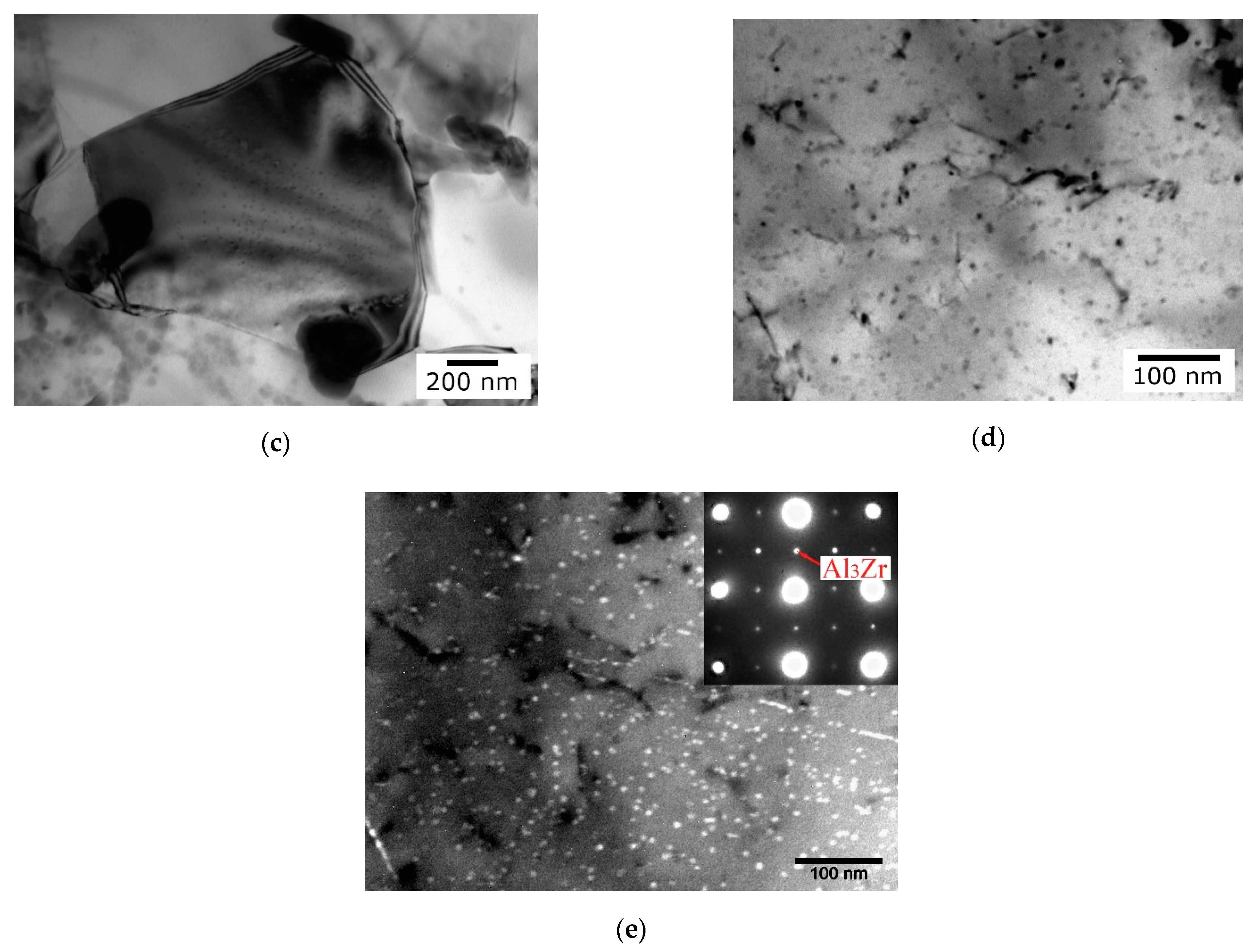


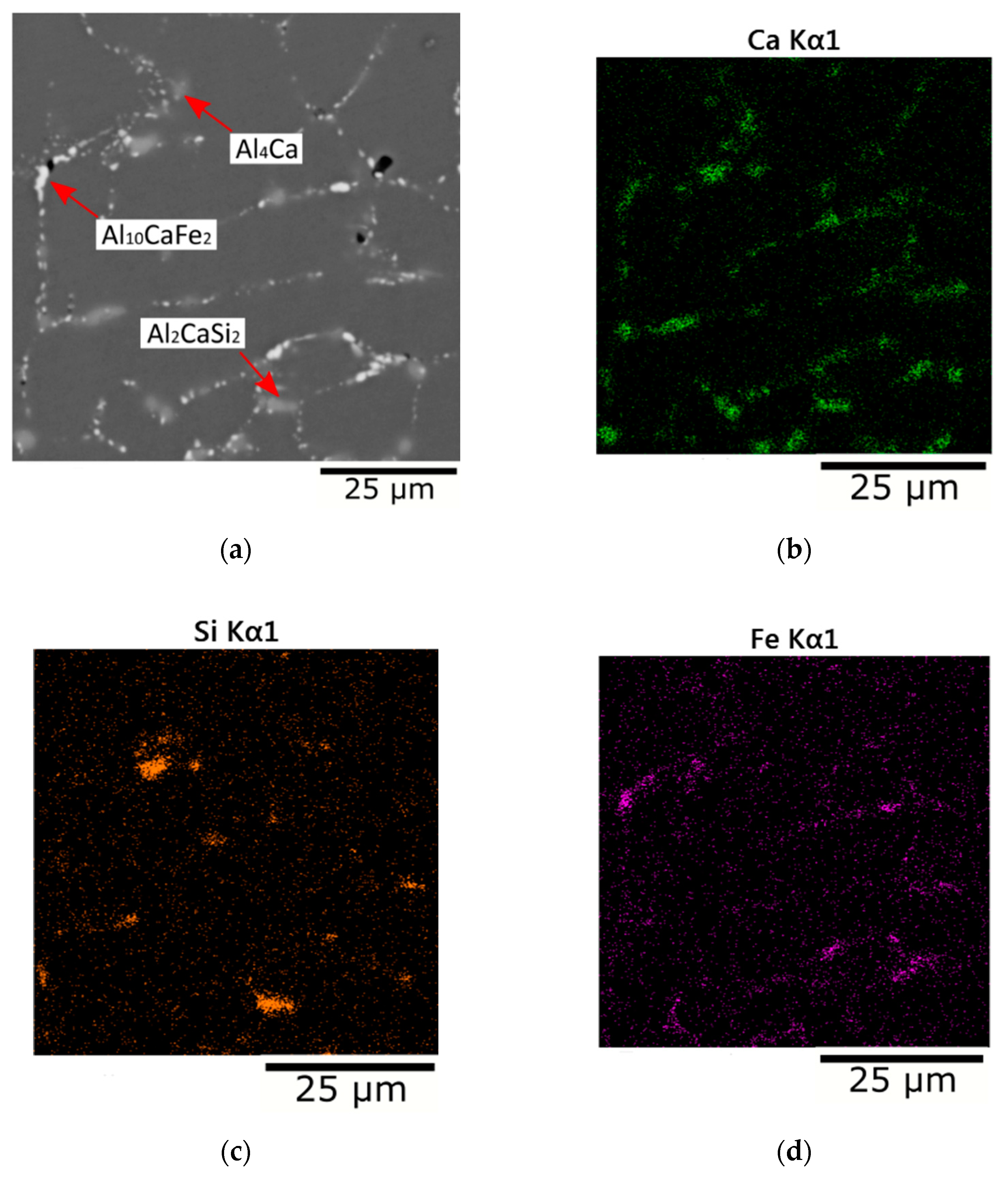
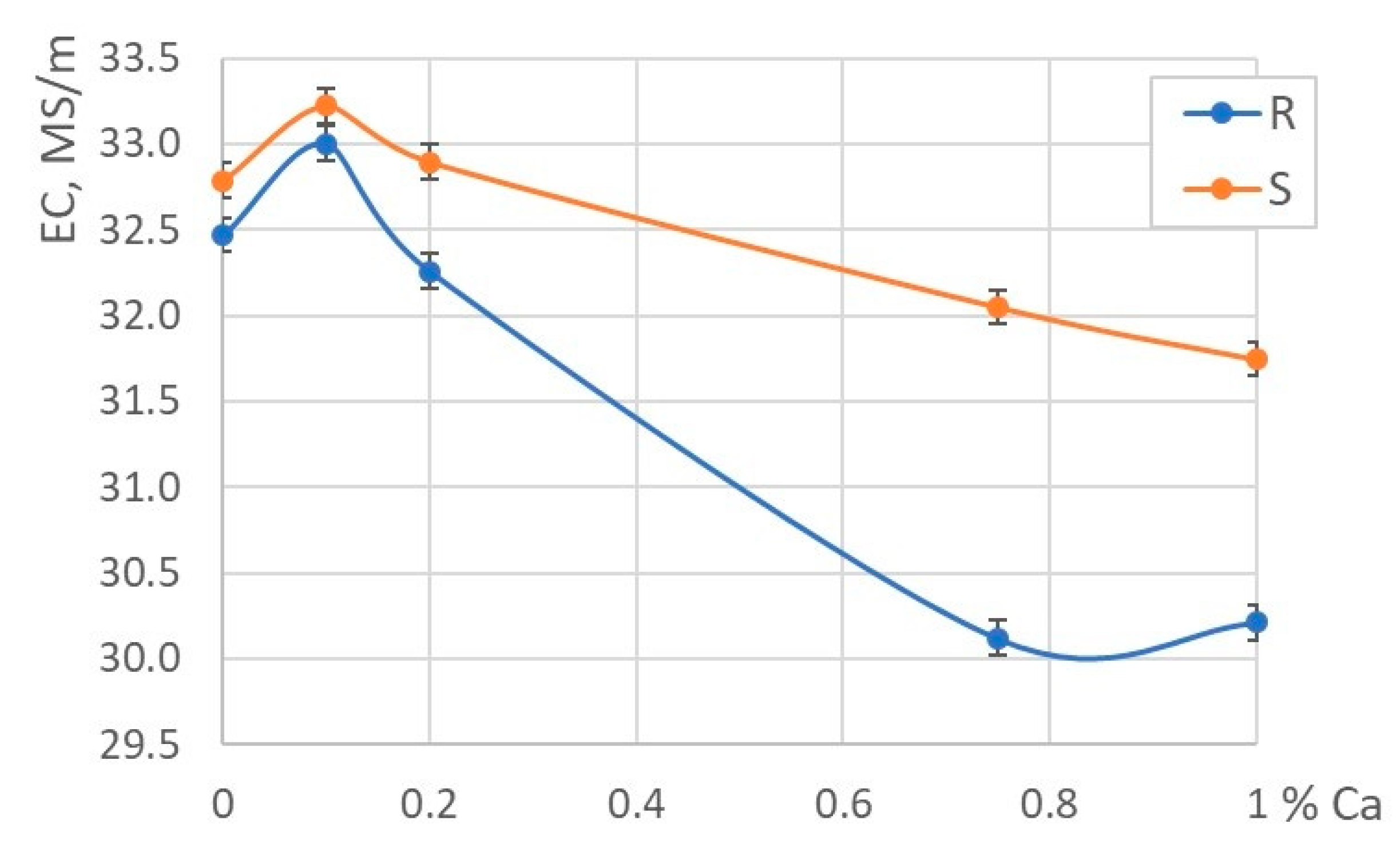
| Designation | Concentration, wt.% (at.%) | ||||
|---|---|---|---|---|---|
| Ca | Fe | Si | Zr | Al | |
| ACZ | 0.81 ± 0.02 (0.55) | 0.48 ± 0.03 (0.23) | 0.24 ± 0.02 (0.23) | 0.46 ± 0.05 (0.14) | balance |
| 0 Ca 1 | – | 0.68 ± 0.04 (0.40) | 0.23 ± 0.03 (0.22) | – | balance |
| 0.1 Ca 1 | 0.13 ± 0.02 (0.09) | 0.67 ± 0.03 (0.33) | 0.22 ± 0.03 (0.21) | – | balance |
| 0.2 Ca 1 | 0.19 ± 0.02 (0.10) | 0.65 ± 0.04 (0.33) | 0.21 ± 0.03 (0.20) | – | balance |
| 0.75 Ca 1 | 0.73 ± 0.03 (0.42) | 0.41 ± 0.04 (0.20) | 0.15 ± 0.03 (0.14) | – | balance |
| 1 Ca 1 | 1.03 ± 0.04 (0.69) | 0.41 ± 0.05 (0.20) | 0.16 ± 0.04 (0.16) | – | balance |
| Designation | Regime Treatment |
|---|---|
| R-EMC casting rod (diameter 12 mm)/S-cold rolled strip (thickness 2 mm) | |
| R/S | As-cast/as-cold rolled |
| R300/S300 | Annealing at 300 °C, 3 h |
| R350/S350 | R300/S300 + annealing at 350 °C, 3 h |
| R400/S400 | R350/S350 + annealing at 400 °C, 3 h |
| R450/S450 | R400/S400 + annealing at 450 °C, 3 h |
| R500/S500 | R450/S450 + annealing at 500 °C, 3 h |
| R550/S550 | R500/S500 + annealing at 550 °C, 3 h |
| R600/S600 | R550/S550 + annealing at 600 °C, 3 h |
| W–Wire (diameter 3 mm) manufactured by cold drawing of as-cast EMC rod | |
| W | As-drawn |
| W350 | W300 + annealing at 350 °C, 3 h |
| W400 | W350 + annealing at 400 °C, 3 h |
| W450 | W450 + annealing at 450 °C, 3 h |
| State | Mechanical Properties | Electrical Properties | |||||
|---|---|---|---|---|---|---|---|
| YS, MPa | UTS, MPa | El, % | HV, MPa | ER, nΩm | EC, MS/m | EC, %IACS | |
| W | 246 ± 12 | 282 ± 7 | 4.1 ± 0.4 | 70 ± 3 | 40.26 | 24.8 | 42.9 |
| W350 | – | – | – | – | 36.10 | 27.7 | 47.8 |
| W400 | 197 ± 2 | 218 ± 1 | 8.9 ± 2.5 | 64 ± 3 | 34.24 | 29.2 | 50.4 |
| W450 | 181 ± 6 | 202 ± 1 | 11.9 ± 1.3 | 60 ± 2 | 31.54 | 31.7 | 54.7 |
| Concentration of Ca, wt.% | Phase Field | Designation in Figure 7a |
|---|---|---|
| 0–<0.01 | (Al) + Al8Fe2Si + Al5FeSi | – |
| <0.01–0.10 | (Al) + Al2CaSi2 + Al8Fe2Si + Al5FeSi | IV |
| ~0.10 | (Al) + Al2CaSi2 + Al8Fe2Si | IV/III |
| 0.10–0.18 | (Al) + Al2CaSi2 + Al3Fe + Al8Fe2Si | III |
| ~0.18 | (Al) + Al2CaSi2 + Al3Fe | III/II |
| 0.18–0.38 | (Al) + Al10CaFe2 + Al2CaSi2 + Al3Fe | II |
| ~0.38 | (Al) + Al10CaFe2 + Al2CaSi2 | II/I |
| >0.38 | (Al) + Al4Ca + Al10CaFe2 + Al2CaSi2 | I |
| Reaction | T, °C | Point in Figure 7b | Concentration in Liquid, wt.% | |||
|---|---|---|---|---|---|---|
| Ca | Fe | Si | Al | |||
| L→(Al) + Al4Ca + Al10CaFe2 + Al2CaSi2 | 611 | E1 | 6.92 | 0.68 | 0.50 | - |
| L→(Al) + Al5FeSi + (Si) + Al2CaSi2 | 576 | E2 | <0.01 | 0.84 | 12.48 | 86.68 |
| L→(Al) + Al3Fe + Al2CaSi2 1 | 632 | E3 | 1.52 | 1.61 | 2.24 | 94.63 |
| L + Al3Fe→(Al) + Al10CaFe2 + Al2CaSi2 | ~620 | P1 | ~6 | ~1 | ~1 | ~92 |
| L + Al3Fe→(Al) + Al8Fe2Si + Al2CaSi2 | 629 | P2 | 0.60 | 1.90 | 3.69 | 93.91 |
| L + Al8Fe2Si→(Al) + Al5FeSi + Al2CaSi2 | 612 | P3 | 0.07 | 1.60 | 7.10 | 91.23 |
Publisher’s Note: MDPI stays neutral with regard to jurisdictional claims in published maps and institutional affiliations. |
© 2021 by the authors. Licensee MDPI, Basel, Switzerland. This article is an open access article distributed under the terms and conditions of the Creative Commons Attribution (CC BY) license (http://creativecommons.org/licenses/by/4.0/).
Share and Cite
Belov, N.; Akopyan, T.; Korotkova, N.; Murashkin, M.; Timofeev, V.; Fortuna, A. Structure and Properties of Ca and Zr Containing Heat Resistant Wire Aluminum Alloy Manufactured by Electromagnetic Casting. Metals 2021, 11, 236. https://doi.org/10.3390/met11020236
Belov N, Akopyan T, Korotkova N, Murashkin M, Timofeev V, Fortuna A. Structure and Properties of Ca and Zr Containing Heat Resistant Wire Aluminum Alloy Manufactured by Electromagnetic Casting. Metals. 2021; 11(2):236. https://doi.org/10.3390/met11020236
Chicago/Turabian StyleBelov, Nikolay, Torgom Akopyan, Natalia Korotkova, Maxim Murashkin, Victor Timofeev, and Anastasiya Fortuna. 2021. "Structure and Properties of Ca and Zr Containing Heat Resistant Wire Aluminum Alloy Manufactured by Electromagnetic Casting" Metals 11, no. 2: 236. https://doi.org/10.3390/met11020236






